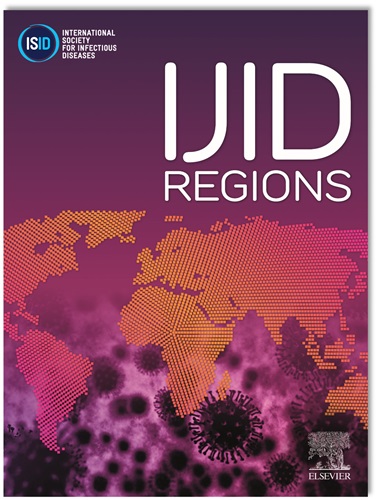Seroepidemiology of respiratory syncytial virus and influenza in infants: A prospective cohort study in China, 2023-2024
IF 4.3
2区 医学
Q1 INFECTIOUS DISEASES
引用次数: 0
Abstract
Objectives
Respiratory syncytial virus (RSV) and influenza are two major pathogens responsible for acute respiratory infections in infants and children. We investigated the dynamic changes of serum antibodies against RSV and influenza in early childhood, aiming to assess exposure rates and factors associated with later exposure, to inform the development of targeted intervention strategies.
Methods
The study performed a community-based prospective cohort seroepidemiological study in children in Jiangsu Province, Eastern China, from February 2023 to August 2024, comprising 16 months of follow-up. Healthy infants aged between 2 and 3 months were recruited. Blood samples were collected from the cohort longitudinally at three study visits: visit 1 (enrollment, 2-3 months of age), visit 2 (5-7 months of age), and visit 3 (18-19 months of age). We detected immunoglobulin (Ig)G antibody concentrations against the RSV prefusion F (pre-F) protein, influenza A/H1N1, influenza A/H3N2, and influenza B using enzyme-linked immunosorbent assays. A four-fold or greater increase of antibody levels compared with baseline or the previous visit was considered as an exposure to RSV or influenza A/B viruses. Confirmed and hospitalization cases were collected through active monitoring of acute respiratory infections during the follow-up. Binary logistic regression models were employed to identify factors associated with exposure.
Results
A total of 357 participants aged 2-3 months were involved in the study. The pre-F IgG geometric mean concentration (GMC) against RSV was 5131.7 ng/ml (95% confidence interval [CI] 4834.0-5447.7) in infants at 2-3 months of age. This decreased to 612.5 ng/ml (95% CI 544.3-689.3) by 5-7 months of age. After that, the GMC of RSV pre-F IgG antibody gradually increased to 1608.1 ng/ml (95% CI 1239.7-2086.0) by 18-19 months. For influenza A/H1N1, A/H3N2, and B viruses, the GMCs of IgG antibodies were 912.4 ng/ml (95% CI 837.1-994.4), 613.9 ng/ml (95% CI 575.5-654.9), and 960.8 ng/ml (95% CI 896.9-1029.3) at 2-3 months of age, respectively. By 5-7 months of age, they declined to 637.5 ng/ml (95% CI 548.1-741.6), 483.9 ng/ml (95% CI 431.3-543.0), and 727.4 ng/ml (95% CI 646.8-818.1). At 18-19 months, GMC against A/H1N1 increased to 955.9 ng/ml (95% CI 833.2-1096.6) again, whereas the response to influenza B showed a marked increase, reaching 1531.9 ng/ml (95% CI 1344.3-1746.0). In contrast, antibody level against A/H3N2 remained relatively stable, with a GMC of 469.5 ng/ml (95% CI 413.6-533.0). The exposure rates were 52.9% for RSV, 28.0% for A/H1N1, 19.6% for A/H3N2, and 37.1% for influenza B. Exploratory analysis further revealed that maternal antibodies serve as protective factors against exposure to both RSV and influenza.
Conclusions
The data revealed the vulnerability of infants to RSV and influenza. These findings provide crucial evidence supporting the necessity of maternal vaccination during pregnancy and infant vaccination in early life.
婴儿呼吸道合胞病毒和流感的血清流行病学:2023-2024年中国的前瞻性队列研究
目的:呼吸道合胞病毒(RSV)和流感是导致婴幼儿急性呼吸道感染(ARIs)的两大主要病原体。我们调查了儿童早期抗RSV和流感的血清抗体的动态变化,旨在评估暴露率和后期暴露的相关因素,为制定有针对性的干预策略提供信息。方法:研究于2023年2月至2024年8月对中国东部江苏省儿童进行社区前瞻性队列血清流行病学研究,随访16个月。招募年龄在2至3个月之间的健康婴儿。在三次研究访问中纵向采集队列血液样本:访问1(入组,2-3个月大),访问2(5-7个月大)和访问3(18-19个月大)。采用酶联免疫吸附法检测抗RSV预融合F(前F)蛋白、甲型H1N1流感、甲型H3N2流感和乙型流感的IgG抗体浓度。抗体水平较基线或前一次就诊增加4倍或更多被认为暴露于RSV或甲型/乙型流感病毒。在随访期间通过主动监测急性呼吸道感染收集确诊病例和住院病例。采用二元逻辑回归模型来确定与暴露相关的因素。结果:共有357名年龄在2-3个月的参与者参与了这项研究。在2-3月龄的婴儿中,f前lgG对RSV的几何平均浓度(GMC)为5131.7 ng/ml (95% CI, 4834.0-5447.7)。到5-7月龄时降至612.5 ng/ml (95% CI, 544.3-689.3)。之后,在18-19个月时,RSV前f抗体的GMC逐渐升高至1608.1 ng/ml (95% CI, 1239.7-2086.0)。甲型H1N1流感病毒、甲型H3N2流感病毒和乙型流感病毒2 ~ 3月龄时lgG抗体的GMCs分别为912.4 ng/ml (95% CI: 837.1 ~ 994.4)、613.9 ng/ml (95% CI: 575.5 ~ 654.9)和960.8 ng/ml (95% CI: 896.9 ~ 1029.3)。到5-7个月大时,它们分别降至637.5 ng/ml (95% CI, 548.1-741.6)、483.9 ng/ml (95% CI, 431.3-543.0)和727.4 ng/ml (95% CI, 646.8-818.1)。在18-19个月时,对甲型H1N1流感的GMC再次增加到955.9 ng/ml (95% CI, 833.2-1096.6),而对乙型流感的反应则明显增加,达到1531.9 ng/ml (95% CI, 1344.3-1746.0)。相比之下,抗A/H3N2抗体水平保持相对稳定,GMC为469.5 ng/ml (95% CI, 413.6-533.0)。RSV暴露率为52.9%,A/H1N1暴露率为28.0%,A/H3N2暴露率为19.6%,b型流感暴露率为37.1%。探索性分析进一步表明,母源抗体对RSV和流感暴露均有保护作用。结论:这些数据揭示了婴儿对呼吸道合胞病毒和流感的易感性。这些发现提供了重要证据,支持孕妇在怀孕期间接种疫苗和婴儿在生命早期接种疫苗的必要性。
本文章由计算机程序翻译,如有差异,请以英文原文为准。
求助全文
约1分钟内获得全文
求助全文
来源期刊
CiteScore
18.90
自引率
2.40%
发文量
1020
审稿时长
30 days
期刊介绍:
International Journal of Infectious Diseases (IJID)
Publisher: International Society for Infectious Diseases
Publication Frequency: Monthly
Type: Peer-reviewed, Open Access
Scope:
Publishes original clinical and laboratory-based research.
Reports clinical trials, reviews, and some case reports.
Focuses on epidemiology, clinical diagnosis, treatment, and control of infectious diseases.
Emphasizes diseases common in under-resourced countries.

 求助内容:
求助内容: 应助结果提醒方式:
应助结果提醒方式:


